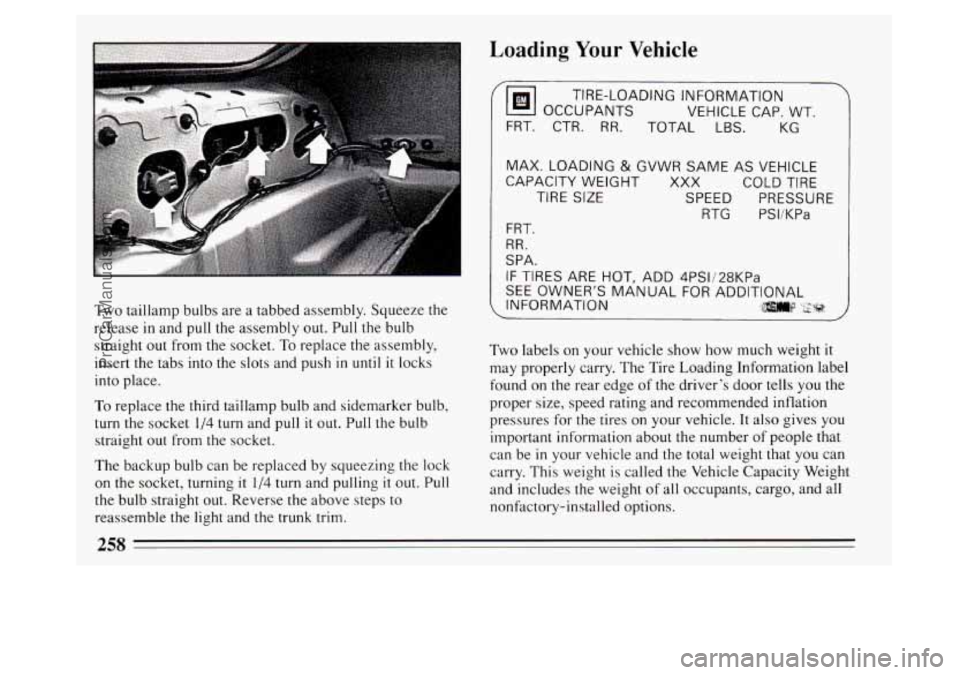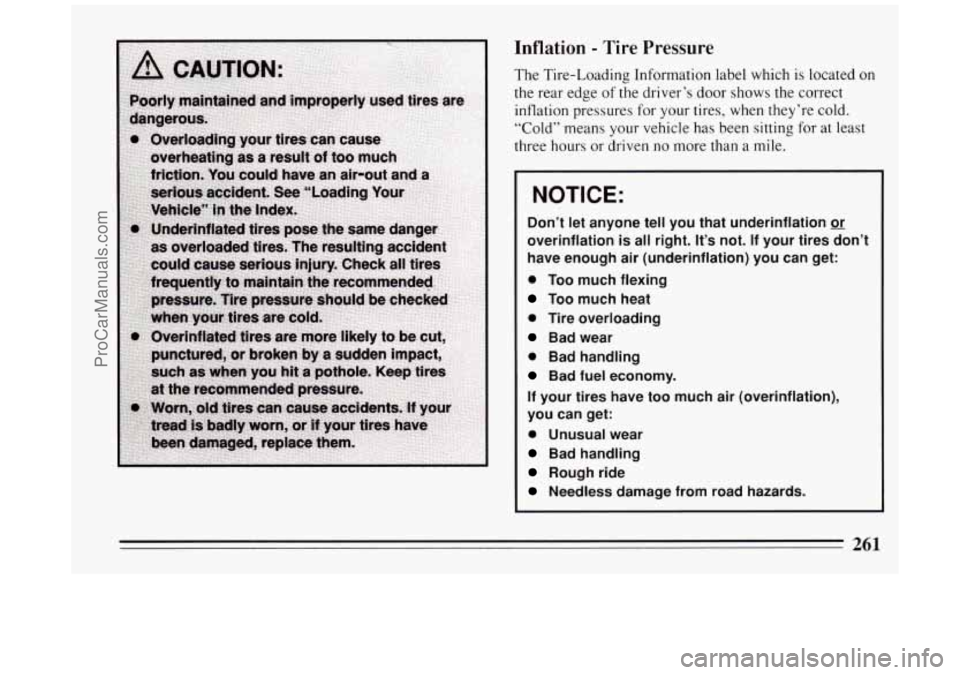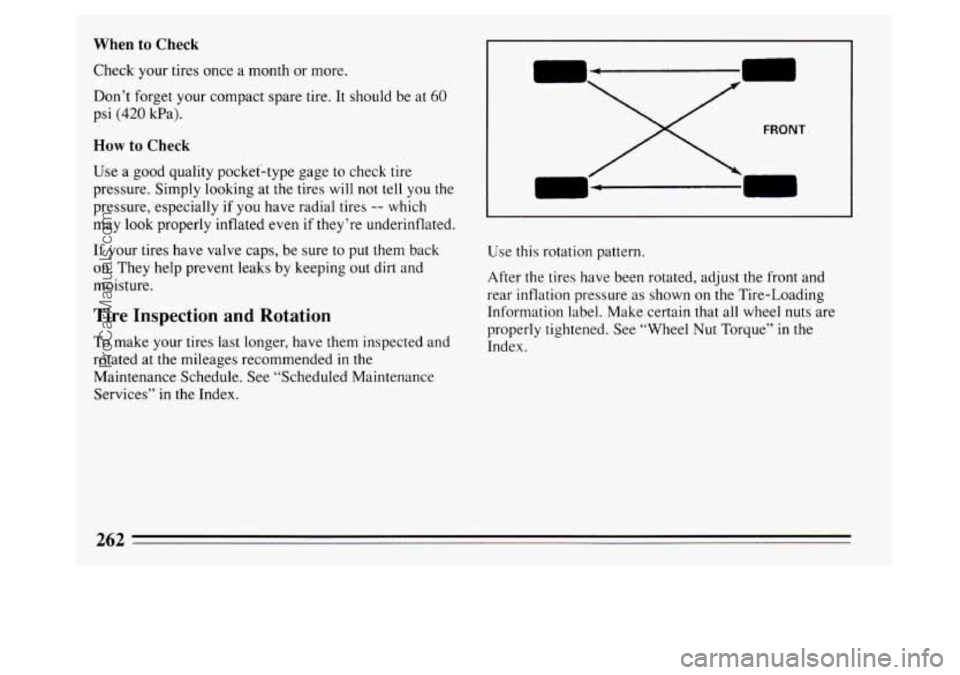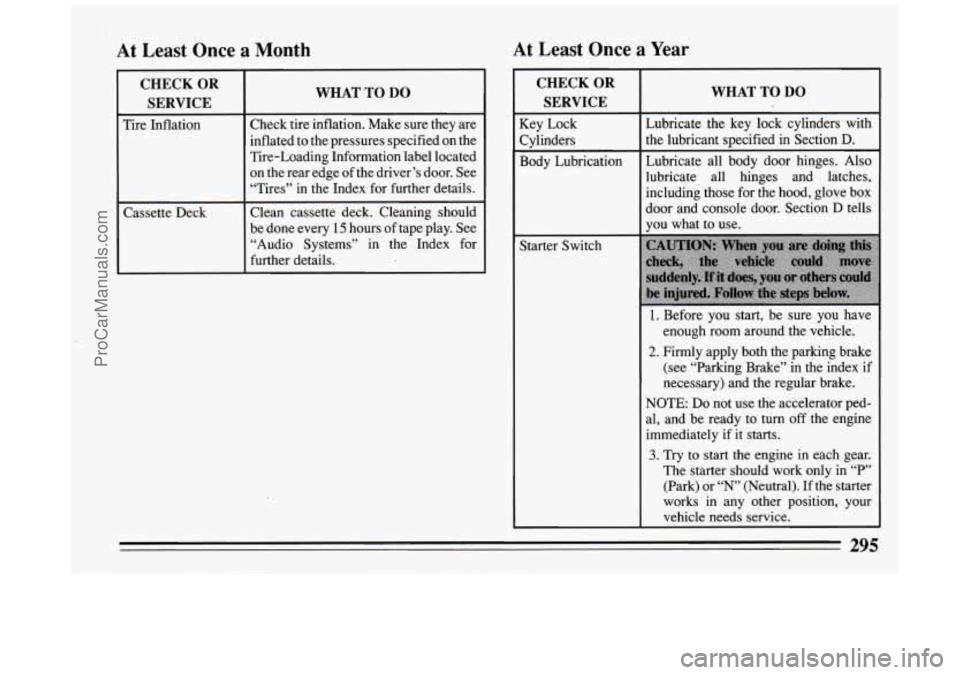inflation pressure BUICK PARK AVENUE 1994 Owners Manual
[x] Cancel search | Manufacturer: BUICK, Model Year: 1994, Model line: PARK AVENUE, Model: BUICK PARK AVENUE 1994Pages: 324, PDF Size: 17.01 MB
Page 226 of 324

Compact Spare Tire
Although the compact spare was fully inflated when
your vehicle was new,
it can lose air after a time. Check
the inflation pressure regularly. It should be
60 psi (420
kPa). After installing the compact spare on your vehicle,
you should stop as
soon as possible and make sure your
spare tire
is correctly inflated. The compact spare is
made to perform well at posted speed limits for
distances up to
3,000 miles (5 000 km). The compact
spare
is made to go up to 3,000 miles (5 000 km), so you
can finish your trip and have your full-size tire repaired
or replaced where you want.
Of course, it’s best to
replace your spare with a full-size tire as soon as you
can. Your spare
will last longer and be in good shape in
case you need it again.
224
ProCarManuals.com
Page 260 of 324

Two taillamp bulbs are a tabbed assembly. Squeeze the
release
in and pull the assembly out. Pull the bulb
straight out from the socket. To replace the assembly,
insert the tabs into the slots and push
in until it locks
into place.
To replace the third taillamp bulb and sidemarker bulb,
turn the socket 1/4 turn and pull it out. Pull the bulb
straight out from the socket.
The backup bulb can be replaced by squeezing the lock
on the socket, turning it
1/4 turn and pulling it out. Pull
the bulb straight out. Reverse the above steps to
reassemble the light and the trunk trim.
Loading Your Vehicle
%I OCCUPANTS
VEHICLE CAP. WT.
TIRE-LOADING INFORMATION
FRT. CTR.
RR. TOTAL LBS. KG
MAX. LOADING
& GVWR SAME AS VEHICLE
CAPACITY WEIGHT XXX
COLD TIRE
TIRE
SIZE SPEED PRESSURE
RTG PSliKPa
FRT.
RR.
SPA.
IF TIRES ARE HOT, ADD 4PS1/28KPa
SEE OWNER'S MANUAL FOR ADDITIONAL
( INFORMATION \]]!mlp ,j;;f&ip
Two labels on your vehicle show how much weight it
may properly carry. The Tire Loading Information label
found on the rear edge of the driver's door tells
you the
proper size, speed rating and recommended inflation
pressures for the tires on your vehicle.
It also gives you
important information about the number of people that
can be
in your vehicle and the total weight that you can
carry. This weight is called the Vehicle Capacity Weight
and includes the weight
of all occupants, cargo, and all
nonfactory-installed options.
ProCarManuals.com
Page 263 of 324

Inflation - Tire Pressure
The Tire-Loading Information label which is located on
the rear edge of the driver’s door shows the correct
inflation pressures for your tires, when they’re
cold.
“Cold” means your vehicle has been sitting for at least
three hours or driven no more than a mile.
NOTICE:
Don’t let anyone tell you that underinflation &r
overinflation is all right. It’s not. If your tires don’t
have enough air (underinflation) you can get:
0 Too much flexing
Too much heat
0 Tire overloading
Bad wear
0 Bad handling
Bad fuel economy.
If your tires have too much air (overinflation),
you can get:
0 Unusual wear
Bad handling
Rough ride
Needless damage from road hazards.
261
ProCarManuals.com
Page 264 of 324

When to Check
Check your tires once a month or more.
Don’t forget your compact spare tire. It should be at
60
psi (420 Wa).
How to Check
Use a good quality pocket-type gage to check tire
pressure. Simply looking at the tires will not tell you the
pressure, especially
if you have radial tires -- which
may look properly inflated even if they’re underinflated.
If your tires have valve caps, be sure to put them back
on. They help prevent leaks by keeping out dirt and
moisture.
Tire Inspection and Rotation
To make your tires last longer, have them inspected and
rotated at the mileages recommended
in the
Maintenance Schedule. See “Scheduled Maintenance
Services”
in the Index.
FRONT
Use this rotation pattern.
After the tires have been rotated, adjust the front and
rear inflation pressure
as shown on the Tire-Loading
Information label. Make certain that all wheel nuts are
properly tightened. See “Wheel Nut Torque” in the
Index.
262
ProCarManuals.com
Page 297 of 324

At Least Once a Month At Least Once a Year
CHECKOR SERVICE I
WHAT TO DO
Tire Inflation
Tire-Loading Information label located
inflated to the pressures specified on the Check
tire inflation. Make sure they are
on the rear edge of the driver’s door. See
“Tires” in the Index for further details.
Cassette Deck Clean cassette deck. Cleaning should
be done every
15 hours of tape play. See
“Audio Systems”
in the Index for
further details.
CHECK OR
SERVICE
Key Lock
Cylinders
Body Lubrication
Starter Switch
WHAT TO DO
Lubricate the key lock cylinders with
the lubricant specified in Section
D.
Lubricate all body door hinges. Also
lubricate all hinges and latches,
including those for the hood, glove box
joor and console door. Section
D tells
you what to use.
1. Before you start, be sure you have
enough room around
the vehicle.
2. Firmly apply both the parking brake
(see “Parking Brake” in the index
if
necessary) and the regular brake.
NOTE:
Do not use the accelerator ped-
al, and
be ready to turn off the engine
immediately if it starts.
3. Try to start the engine in each gear.
The starter should work only in
“P’
(Park) or “N’ (Neutral). If the starter
works in any other position, your
vehicle needs service.
295
ProCarManuals.com